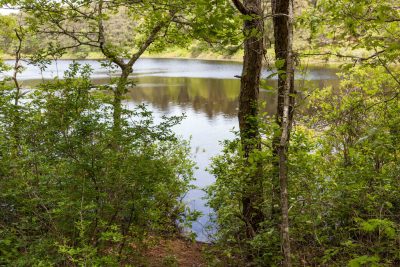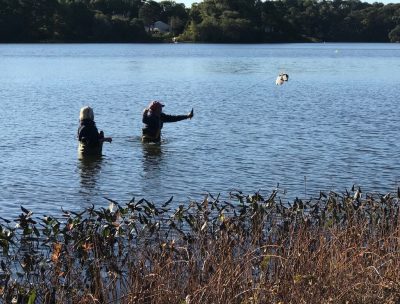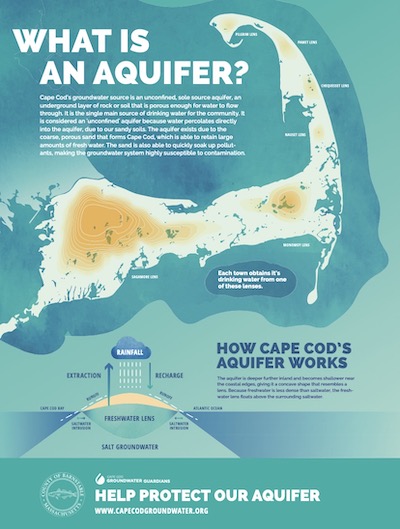Friends of Chatham Waterways established the Pond Study Group, a sub-committee, in 2012 to initiate the study and protection of Chatham’s freshwater ponds. The Group was asked to implement a program to collect important data from several ponds and to educate the public about the importance of ponds and how to keep them healthy.
In the summer of 2015 testing of six of Chatham’s fresh water ponds began: Barclay, Emery, Lovers, Schoolhouse, Stillwater, and White. Pond volunteers collected data on turbidity, dissolved oxygen levels, and temperature. Over time testing will be expanded to include other ponds that are significant to our aquifer, wildlife habitat and recreation. Click here for more info on Pond Water Quality testing.
In 2018 the freshwater pond studies was expanded to monitor for toxic algae (cyanobacteria). The purpose of this program is to identify any potential toxicity before it becomes a public health matter. Five ponds with public access were identified: Lovers, Stillwater, White, Schoolhouse, and Goose. Samples are taken twice per month from late spring and into early fall. Click here for more info on Cyanobacteria testing.
Both programs are carried out with the assistance and cooperation of Chatham’s Department of Natural Resources which provides the protocols, technical assistance, testing equipment, and data analysis.
In addition to overseeing pond testing, the Pond Study Group’s public educational efforts have focused on the relationship between our ponds and our drinking water. Since Chatham’s drinking water comes from a single source aquifer (like the rest of the Cape), it’s important that our ponds remain healthy. Through articles in the newspaper and occasional speakers, the Group reminds citizens about the challenges to fresh water quality that come from the same sources that threaten our embayments: primarily septic systems, fertilizers, and storm water runoff. We encourage best practices in property care and provide information on being responsible stewards of our beautiful ponds. Click here or our brochure on ways you can keep your pond healthy.
Since the summer of 2015 the Pond Study Group has written a series of short articles for the Cape Cod Chronicle, focusing on various values of and impacts on fresh water ponds, such as new ways of thinking about home landscapes, best management practices when using fertilizer near fresh water bodies, understanding the relationship between ponds and drinking water, etc.
The Group also published the Green Pages, a guide to best practices in protecting our freshwater assets.
To join FCW’s corps of ‘citizen scientists’ and to help us improve the quality of our waterways, click here
Water Quality Testing
Friends of Chatham Waterways (FCW ) began testing six of Chatham’s freshwater ponds in 2015: Barclay, Emery, Lovers, Schoolhouse, Stillwater, and White. Pond volunteers collected data on dissolved oxygen (DO) levels, turbidity, and temperature. Over time testing will be expanded to include other ponds that are significant to our aquifer, wildlife habitat and recreation.
A healthy pond environment is one where the conditions within the pond support a balanced ecosystem. It has been apparent for many years that most of the Cape’s ponds are stressed and out of balance. It’s believed that the main cause for the degradation is excess nutrients from human activity—septic systems, fertilizers, etc.
One of the key measurements volunteers take is Dissolved Oxygen (DO), the most critical indicator of a pond’s health and water quality.
DO levels in natural waters are dependent on the physical, chemical and biochemical activities prevailing in the water body. Oxygen is added to aquatic ecosystems by aquatic plants and algae through the process of photosynthesis; and by diffusion at the water’s surface and atmosphere interface. Animal and plant respiration and decomposition are major causes of oxygen depletion. When the oxygen is used up in the bottom of the lake, anaerobic bacteria continue to breakdown organic materials, creating toxic hydrogen sulfide gas in the process.
Temperature is measured since when considering oxygen levels in a pond warmer water cannot hold as much oxygen as cooler water. A difference of 1°C (33.8° F) or more between surface temperature and temperature at depth indicates that the pond is stratified, and is therefore in danger of having low oxygen levels below the surface.
Turbidity or clarity is also measured since excess phosphorus introduced into ponds increases vegetative growth that turns the water murky and eutrophic, making it uninhabitable for aquatic pond life and threatening the pond’s natural beauty and recreational uses.
Chatham’s Department of Natural Resources assists with the project by training and certifying volunteers in the use of the equipment and analyzing the data collected. This is a long term study to gauge the health of our ponds, discern trends, and consider any necessary remedy.
2018 Volunteer Pond Watchers: Michael Brown & Lisa Holt, Mike & Jackie Page, Michael & Margaret Tompsett, Dianne Semsel, Sandy Giorgetti, Bob Montbach, Nancy & Damian Barr.
Cyanobacteria Testing
Friends of Chatham Waterways (FCW )has been managing the salt water quality testing program (Water Watchers) since 1999, and began testing six of Chatham’s freshwater ponds in 2015. In 2018 a new testing program was added—collecting water samples to test for the presence of cyanobacteria.
The goal is to identify any potential toxicity before it becomes a public health matter.
Volunteers are trained in the use of the equipment and protocols. Teams of two volunteers are assigned to a pond location. On 11 testing dates in the season they collect water samples close to the shoreline, record water temperature, and make general observations about conditions.
FCW contracted with the Association to Preserve Cape Cod (APCC) to provide the protocols and training, and to manage the sampling, testing, and analysis of the data. APCC piloted the program in 2017 in Brewster. Protocols and quality controls developed by the Commonwealth are employed.
What is Cyanobacteria?
Cyanobacteria, also referred to as blue-green algae, have unfortunately become a regular news story--from the Great Lakes to Chesapeake Bay to Lake Okeechobee, and now to Cape Cod. Many Cape towns have experienced toxic blooms, and several have already begun proactive water quality testing.
This condition is somewhat similar to the ‘red tide’ that occasionally appears in salt waterways and, because of their toxicity, results in the temporary closing of shellfish beds. Freshwater blooms can form when cyanobacteria multiply quickly and form “scums” or “mats” on the surface of the water. Blooms can occur at any time but most often occur in late summer or early fall. Under the right conditions, cyanobacteria can multiply quickly and pose a health risk to those coming into contact with the water. Not all algal blooms are toxic—most are not—but they are, nevertheless, harmful for pond ecology.
Changes in climate, as well as nutrient overload from septic systems, fertilized lawns and stormwater runoff contribute to declining water quality across the Cape. In freshwater ponds (especially kettle ponds) increased nutrient inputs (particularly phosphorus and nitrogen) may lead to harmful cyanobacteria blooms.
Monitoring water quality of ponds can give communities advance warning, so they can adequately plan and deal with the adverse environmental and health effects associated with a harmful bloom. The goals of this monitoring program are to bring public awareness about cyanobacteria blooms, provide information to local health officials who have the authority to post advisories when warranted, and to encourage property owners to reduce fertilizer use, manage stormwater on their properties, and hook up to town sewer as soon as it is available.
The Association to Preserve Cape Cod hosts an interactive map with the latest test results, and you can learn more about cyanobacteria from the MA Department of Public Health.
Cape Cod’s Sole Source Aquifer
Cape Cod’s drinking water and municipal fresh water supply is provided by a single source, an unconfined groundwater aquifer that is comprised of six separate groundwater lenses spanning the length of the Cape (see Figure 1). An aquifer is an underground body of permeable bedrock, bedrock fractures, and soil that can store and transmit groundwater. The bottom of the Cape’s sole source aquifer is formed by the presence of an impermeable bedrock layer, located approximately 125-325 feet below the ground surface depending on the location, that prevents water from flowing any deeper into the earth’s crust. Since freshwater is lighter than saltwater, the bottom of the freshwater aquifer sits perched above a layer of salty groundwater which is located immediately above this impermeable bedrock layer. The lateral extent of the Cape’s freshwater aquifer system is defined by the presence of Nantucket Sound to the south, the Atlantic Ocean to the east, and Cape Cod Bay to the north. The shape of this perched groundwater aquifer is much thicker in the middle of the Cape where it is farthest away from the coastline and the influence of the adjacent saltwater bodies. The Cape’s groundwater aquifer thins significantly with increased proximity to the coastlines where it forms six separate convex lenses.
The Cape’s freshwater aquifer is considered unconfined because water in the form of precipitation and surface runoff very easily percolates downward into the aquifer through the hundreds of feet of medium and coarse sand that was left behind when the glaciers advanced and retreated some 15,000 to 21,000 years ago. These glacial processes produced a highly variable sandy surface topography across the Cape that includes moraines, outwash plains, streams, drainages, shallow kettle holes, and freshwater ponds. Cape Cod has approximately 994 freshwater ponds, ranging in size from less than an acre to approximately 735 acres, the vast majority of which represent a surface expression of this sole source aquifer where the elevation of the groundwater table exceeds the elevation of the surrounding land surface. Due to the very high hydraulic conductivity of the glacial sand that makes up Cape Cod, combined with the region’s reliance on precipitation as the only source of freshwater recharge, this sole source aquifer is highly susceptible to sources of pollution and contamination that easily infiltrate into the groundwater and/or flow directly into a nearby pond.
Protecting Cape Cod’s sole source aquifer from pollution and contamination is essential to the health and well-being of the people that live, work on, and visit the Cape. Maintaining the quality of this groundwater resource and the aquatic ecosystems it supports is essential to the resiliency of the fishing, shell fishing, and tourist industries that underpin the Cape’s economy and to the maintenance of the unique wildlife resources we find here. Please do your part and protect Cap Cod’s sole source aquifer and consider what actions you can take to protect this essential resource. The Cape’s freshwater ponds and drinking water supply rely upon good stewardship and smart choices!
For more information please click the link to EPA’s Region 1 drinking water page at https://www3.epa.gov/region1/eco/drinkwater/capecod.html or go the Cape Cod Commission’s sole source aquifer page at https://www.capecodcommission.org/our-work/sole-source-aquifer/



